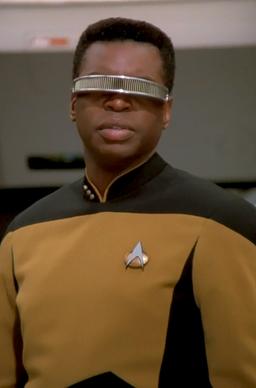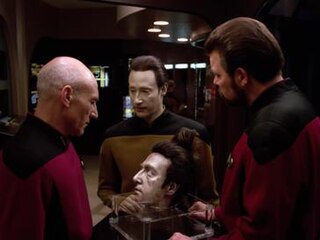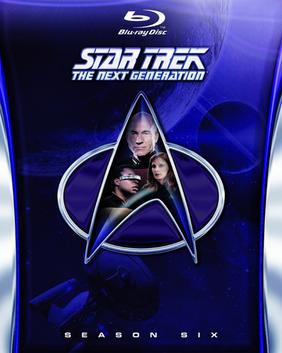| "Masks" | |
|---|---|
| Star Trek: The Next Generation episode | |
| Episode no. | Season 7 Episode 17 |
| Directed by | Robert Wiemer |
| Written by | Joe Menosky |
| Featured music | Dennis McCarthy |
| Production code | 269 |
| Original air date | February 21, 1994 |
| Guest appearance | |
| |
"Masks" is the seventeenth episode of the seventh season of the American science fiction television series Star Trek: The Next Generation , the 169th episode overall.
Set in the 24th century, the series follows the adventures of the Starfleet crew of the Federation starship Enterprise-D. In this episode, an alien archive, like an alien Library of Alexandria, [1] initially appearing as a rogue comet because of accumulated matter, transforms the Enterprise as well as adapting Lieutenant Commander Data for a re-enactment of its culture's mythology, including the creation of two masks which are stylistically "a kind of cross between Venetian and Mayan." [2]
A classroom of children on the Enterprise-D and Data are making clay sculptures under the supervision of Deanna Troi when a mysterious-looking rogue comet is discovered that is determined to have been en route from a distant star system for eighty-seven million years (since the mid-Cretaceous). The crew initiates a sensor scan of it, triggering a flash of light onboard and a distortion within the comet's inner core. Sensors are reconfigured for a low intensity sweep which will last thirty-nine hours. Eighteen hours later, Data creates a clay mask with a compass symbol identical to that seen on an artifact found in Troi's quarters and on Eric Burton's computer terminal, raising suspicions. It is discovered that the comet has been using the Enterprise scans as a carrier wave to send information back to the ship; this has caused icons (alien-looking ideographic symbols like Mayan glyphs) which Data is somehow able to read to appear on the ship's computer and the creation of artifacts throughout the ship by the replicator systems. The crew use a phaser beam to remove the outer shell of the comet nucleus and find that an "incredible, huge, Mayan-esque, geometric piece of technology" was at the inner core of the former comet nucleus. Data believes that the object is an informational archive and is confined to his quarters when he starts to exhibit what is described as the equivalent of multiple personalities, initially assuming the personality of the mischievous Ihat, but soon manifesting others, such as a sacrificial victim, a frightened boy, and a tired elderly man, each of which has an identifying ceremonial neckplate. Though initially the Enterprise continues to scan the Archive, hoping to determine how to reverse or stop the changes, bit by bit, the ship is being transformed, so the crew decide to attempt to destroy the Archive, only to be impeded by the changes. The Archive activates a tractor beam, overriding ship control systems. While Geordi searches for the Archive's transformation program, Captain Picard determines that they need to understand the meanings of the artifacts, and talks to the various personalities that Data exhibits to learn more. [3]
Through Ihat, Picard learns that a queen called Masaka is waking, and that the only one that can talk to her is one called Korgano, a masculine figure. Ihat states that Masaka will only appear once Masaka's temple (the Queen's temple) has been built. The elder, another of the personalities exhibited by Data who is believed to be Masaka's father, provides Picard with the full version of the temple symbol, an icon that is used to create that temple. Inside the temple, they find the Masaka sun image paired with a horn symbol, which Picard guesses may be Korgano's moon symbol. Data puts on the mask he had created from clay with Masaka's sun symbol on it and escapes from his quarters, arriving at Masaka's temple, where he, now manifesting Masaka, sits down upon the throne. Masaka refuses to communicate with the merely mortal Picard. Desperate, Picard has Geordi input Korgano's moon symbol into the Archive's transformation program, which produces a silver mask with Korgano's moon symbol on its forehead. Picard decides to wear the Korgano mask in order to pose as Korgano and confront the Masaka personality. In the character of Korgano, Picard convinces Masaka to sleep so that she and Korgano can continue their "hunt" another day. With the Masaka personality asleep, all the changes aboard the Enterprise are reverted, and Data finds himself back to normal. Geordi manages to disable the archive's transformation program. Picard comments that Data has, briefly, contained personalities encompassing the inhabitants of an entire civilization, and as such he has had an experience that "transcends the human condition." [1] [4] [5] [6]
The episode has been described as "incomprehensible, impenetrable, and incoherent." [7] Empire magazine declared "Masks" its choice as worst episode of the entire Star Trek: The Next Generation series. Technically, it was chosen as second-worst, but Empire decided that "Shades of Gray"—its initial choice for worst episode—didn't count, because "Shades of Gray" was a flashback 'clip' episode. [8]
The 2008 book Computers Of Star Trek suggested that what was in the comet and began converting the spacecraft, was a kind of trojan-horse software program left by the D'Arsay aliens. [9] The Religions Of Star Trek notes that the masks are the core drama of this episode, relating to a theme of things being hidden and then revealed. [10]
In 2014, Ars Technica described it as one of the bad episodes of the seventh season, but praised it for "let[ting] Brent Spiner play around and have some fun." [11]
In 2019, Screen Rant ranked "Masks" the tenth worst episode of Star Trek: The Next Generation based on IMDB ratings; they reported that it was 6.1 out of 10 at that time. [12]
This was released in Japan on LaserDisc on October 9, 1998 as part of the half-season collection Log.14: Seventh Season Part.2. [13] This set included episodes from "Lower Decks" to Part II of "All Good Things", with English and Japanese audio tracks. [13]

Geordi La Forge is a fictional character who appeared in all seven seasons of the American science fiction television series Star Trek: The Next Generation and its four feature films as well as the third season of Star Trek: Picard. Portrayed by LeVar Burton, he served as helmsman of the USS Enterprise-D in the first season of The Next Generation, then occupied the role of the chief engineer for the rest of the series and in the films before appearing as a commodore in Picard. La Forge has been blind since his birth and uses technological devices that allow him to see – a VISOR in the series and the first film, replaced by ocular prosthetic implants in the last three films and in Picard.
"The Enemy" is the seventh episode of the third season of the syndicated American science fiction television series Star Trek: The Next Generation, the 55th episode overall, first broadcast on November 6, 1989.
"Ship in a Bottle" is the 138th episode of the American science fiction television series Star Trek: The Next Generation, the 12th episode of the sixth season.
"Datalore" is the thirteenth episode of the first season of the American science fiction television series Star Trek: The Next Generation, originally aired on January 18, 1988, in broadcast syndication. The story was created by Robert Lewin and Maurice Hurley, and turned into a script by Lewin and the creator of the show, Gene Roddenberry. It was Roddenberry's final script credit on a Star Trek series. The director was originally to be Joseph L. Scanlan, but following delays in pre-production caused by script re-writes, it was reassigned to Rob Bowman.
"Samaritan Snare" is the seventeenth episode of the second season of the American science fiction television series Star Trek: The Next Generation, and the 43rd episode overall. It was first released on May 15, 1989, in broadcast syndication.

"Time’s Arrow" is the 26th episode of the fifth season and the first episode of the sixth season of the American science fiction television series Star Trek: The Next Generation. It comprises the 126th and 127th episodes of the series.
"Schisms" is the 131st episode of the American science fiction television series Star Trek: The Next Generation and the fifth of the sixth season. It was originally aired on October 19, 1992.
"Sub Rosa" is the 165th episode of the American science fiction television series Star Trek: The Next Generation. It was the 14th episode of the seventh season.
"Thine Own Self" is the 168th episode of the American science fiction television series Star Trek: The Next Generation, and the 16th episode of the seventh season.
"Starship Mine" is the 144th episode of the American science fiction television series Star Trek: The Next Generation, the 18th episode of the sixth season. The episode marked an early appearance of actor Tim Russ in the Star Trek canon prior to his being cast as Tuvok on Star Trek: Voyager.
"Data's Day" is the 85th episode of the American science fiction television series Star Trek: The Next Generation, the 11th episode of the fourth season. This episode introduces both Keiko O'Brien and Data's pet cat, Spot.
"Deja Q" is the 13th episode of the third season of the American science fiction television series Star Trek: The Next Generation, and the 61st episode of the series overall. This episode aired on syndicated television in February 1990.
"Identity Crisis" is the 92nd episode of the American science fiction television series Star Trek: The Next Generation. The 18th episode of the fourth season. The episode first aired in broadcast syndication on March 25, 1991.
"Night Terrors" is the 91st episode of the American science fiction television series Star Trek: The Next Generation; the 17th episode of the fourth season.
"Galaxy's Child " is the 90th episode of the American science fiction television series Star Trek: The Next Generation, the 16th episode of the fourth season. It was originally released on March 11, 1991, in broadcast syndication.

The fifth season of the American science fiction television series Star Trek: The Next Generation commenced airing in broadcast syndication in the United States on September 23, 1991, and concluded on June 15, 1992, after airing 26 episodes. Set in the 24th century, the series follows the adventures of the crew of the Starfleet starship Enterprise-D.

The sixth season of the American science fiction television series Star Trek: The Next Generation commenced airing in broadcast syndication in the United States on September 21, 1992, and concluded on June 21, 1993, after airing 26 episodes. Set in the 24th century, the series follows the adventures of the crew of the Starfleet starship Enterprise-D.

The seventh and final season of the American science fiction television series Star Trek: The Next Generation commenced airing in broadcast syndication in the United States on September 20, 1993, and concluded on May 23, 1994, after airing 26 episodes. Set in the 24th century, the series follows the adventures of the crew of the Starfleet starship Enterprise-D.
A Mask -- a kind of cross between Venetian and Mayan.
The story is at times so incomprehensible, impenetrable, and incoherent as to require three synonyms starting with the letter "I" for me to adequately convey its bewildering effect.